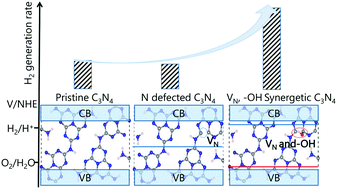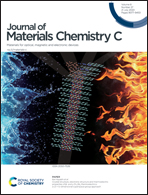Synergetic defects boost charge separation in CN for enhanced photocatalytic water splitting†
Abstract
Defect engineering of graphitic carbon nitride (CN) has been proved to enable the alignment of energy levels for enhanced photocatalytic H2 evolution (PHE). As the majority of defects in imperfect structured CN, “native” defects are critical but their role in PHE still lacks in-depth understanding. In this work, nitrogen vacancy, hydroxyl or nitrogen vacancy and hydroxyl co-modified CN was prepared by thermodynamic atmosphere control of the polymerization. It was found that the hydrogen production rate of nitrogen vacancy and hydroxyl co-modified CN is about 2253.6 μmol h−1 g−1, about 3.0 times the PHE rate of either nitrogen vacancy or hydroxyl modified CN. Further transient photocurrent, electrochemical impedance spectroscopy and transient PL characterization confirmed the enhanced photogenerated electron–hole separation by the synergetic effects of the two defects in co-modified CN. In combination with density functional theory calculations, we revealed that co-modification of nitrogen vacancy and hydroxyl introduced gap states in the vicinity of the VBM and CBM of the host material, respectively, while deep trap states can be formed for CN modified by a single-type defect of nitrogen vacancy or hydroxyl.



 Please wait while we load your content...
Please wait while we load your content...